GAT 033 Ho Tzu Nyen
Situating the Void of Times (Problems of Curating)

Ho Tzu Nyen, a Singapore-based artist who uses video, multimedia, also sometimes curatorial methods, is philosophically exploring post-colonial Southeast Asia, from modernity until today. How can we understand the region of “Southeast Asia?” The following is an excerpt from an online talk given on July 2, 2022.
Edited by Ishii Jun’ichiro (ICA Kyoto)
I would like to speak a little bit about an ongoing project that I have been working on since 2012, which is «The Critical Dictionary of Southeast Asia». What we are seeing here is a website, so anyone can access it at any time. On this website, what we will encounter is a film which is being edited in real time by a set of algorithms. I would say, every use of the film will be different. I would like to speak a little bit about the starting points of this project.
I would say, perhaps, we can describe this project as beginning a question and the question is, “What constitutes the unity of Southeast Asia, a region never unified by a single religion, language or political system?”
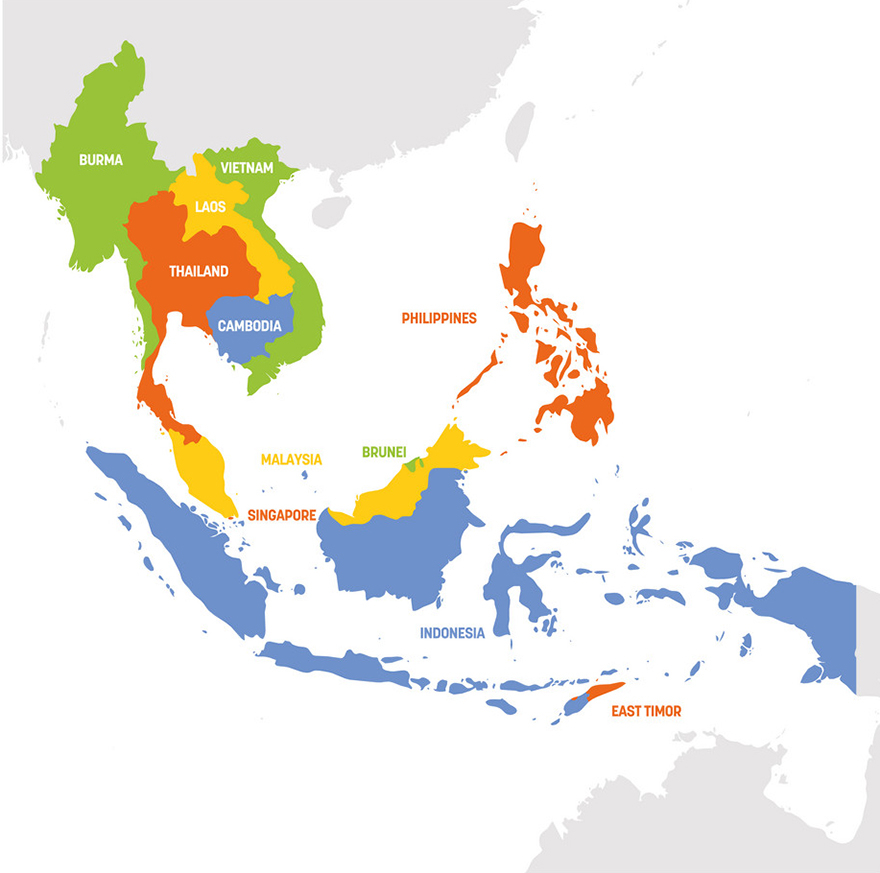
Map of Southeast Asia
Southeast Asia is a very heterogeneous area. For example, if we think about Vietnam, on the topmost part and Indonesia at the southern end of Southeast Asia, these are, totally different in terms of culture. So why are all these different nations considered as one single region? So that is my starting question.
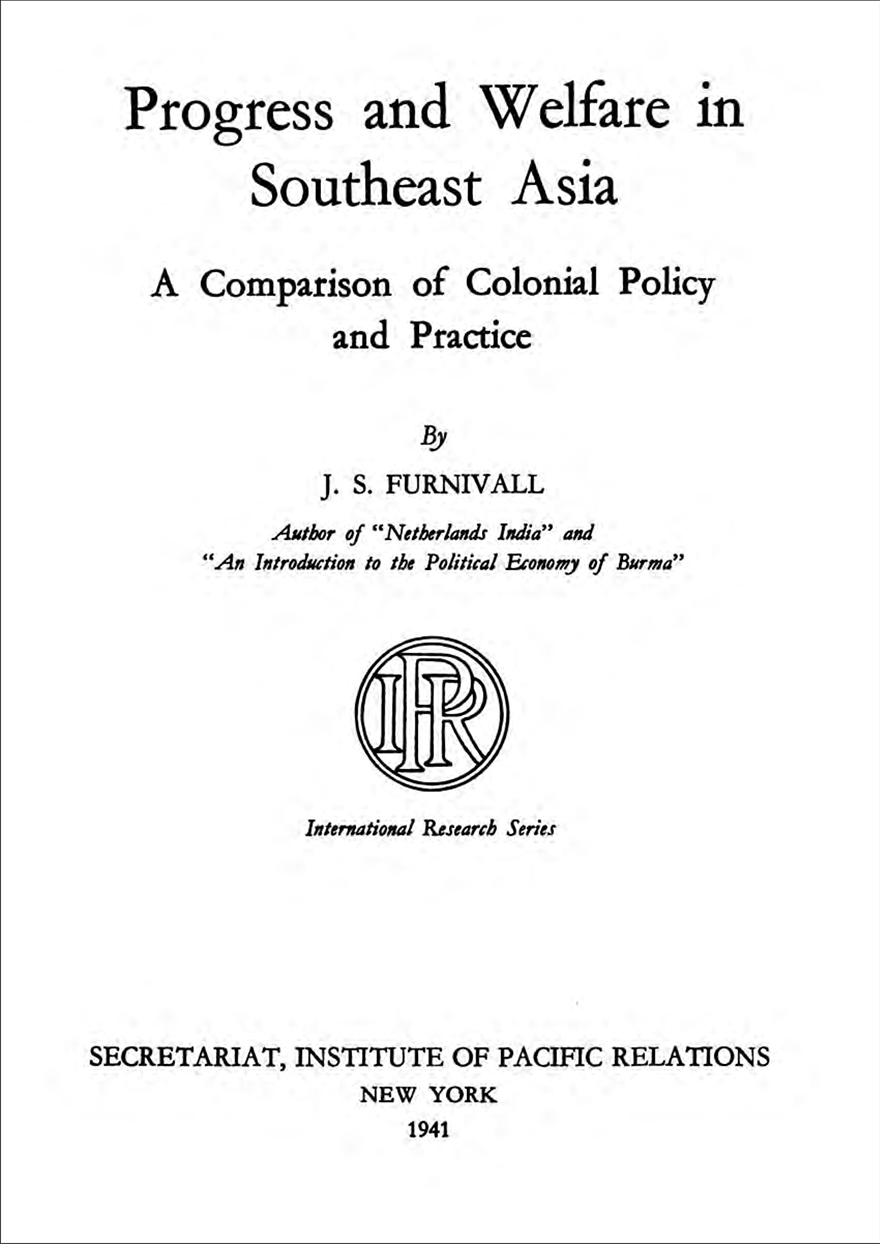
John Sydenham Furnivall, Progress and Welfare in Southeast Asia, 1941
This is a book published in 1941. According to Benedict Anderson, a great Southeast Asian scholar, the name Southeast Asia first appeared in its modern sense in the title of this book, but this book was only circulated in the academy.
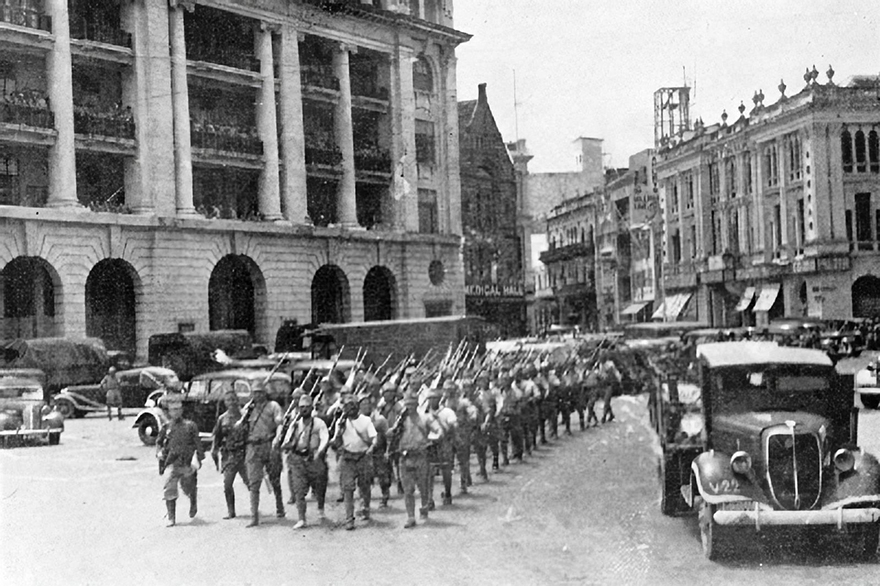
The Japanese 25th Army (第25軍) in Singapore, February 1942
It was not widely known at all. I would say the name Southeast Asia and how it became more widely circulated was tied actually to a very particular moment of our history, which is the Japanese invasion and Japanese occupation of the region. So, during the Second World War, the Allied forces came together to create a command center known as the Southeast Asian Command. This was meant to be a strategic unit aimed to liberate Southeast Asia from Japanese occupation. But of course, these were the colonial powers, which formerly occupied Southeast Asia. In other words, they wanted to liberate Southeast Asia in order to recolonize.

The flag of the South East Asia Command (SEAC) during WW2
Shortly after the end of the Second World War, that term Southeast Asia became much more popular. It began to be used in American universities. They started having departments or programs dedicated to the study of Southeast Asia. This is something very closely linked to Cold War politics. American forces wanted to understand Southeast Asia, partially in order to stop the spread of communism in this area. So, in many senses, Southeast Asia as a region was born during the war. And I would say that the Japanese occupation also synchronized this entire period under one political system.
◉
Now, I would like to move into another project, which I wanted to discuss in this talk, which is an exhibition that I co-curated with the Taiwanese artist Hsu Chia-Wei the Asian Art Biennial, which was held in Taichung in 2019.
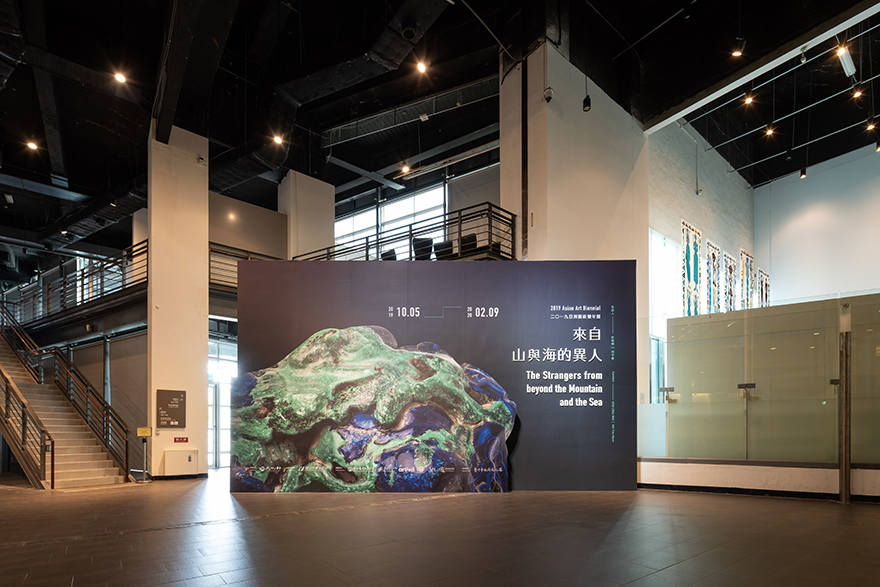
The Strangers from beyond the Mountian and the Sea_7th Asian Art Biennial, National Taiwan Museum of Fine Arts, Taichung.
Curated by Hsu Chiawei and Ho Tzu Nyen. Photograph courtesy of National Taiwan Museum of Fine Arts
I remember one of my starting conversations with Hsu Chia-Wei thinking about this exhibition was actually two areas related to Southeast Asia that interested us, and which came out of my critical dictionary project.
The first vision we like to think is what is now commonly referred to as the Zomia area.
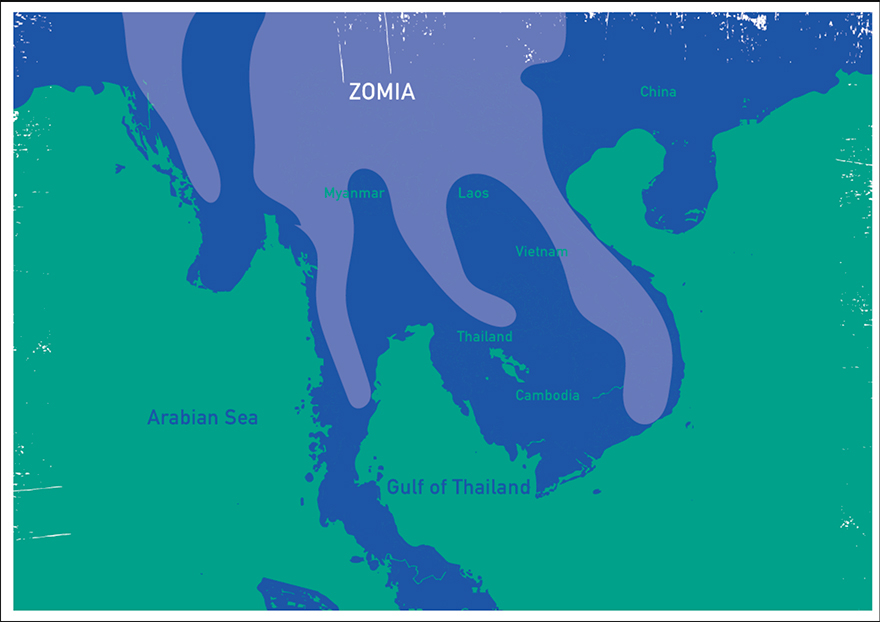
Zomia
The Zomia area is a high land area that cuts across many different countries in Southeast Asia such as Laos, Vietnam, Thailand, Cambodia, Myanmar… it also cuts into China and parts of India.
Throughout history, many of these nation states have tried to occupy parts of the Zomia area, but they always find it difficult to do it. Because, in the words of James C. Scott, an American anthropologist, armies run out of breath in high altitudes. So Zomia is a high land area that comes out of the Himalayan mountains.
Size of Zomia, I think, it’s probably bigger than whole Europe, and many ethnic minorities, anti-states guerrilla, escape into this area. Actually, the Golden Triangle which known as a drag producing area in Southeast Asia is also located in this reason, so we can describe this as an organically Anarchist space.
After looking at the high altitude’s anarchism of Zomia, we also wanted to look at a different form of anarchism in the low altitude area, particularly this zone, known as the Sulu Sea or the Sulu zone.
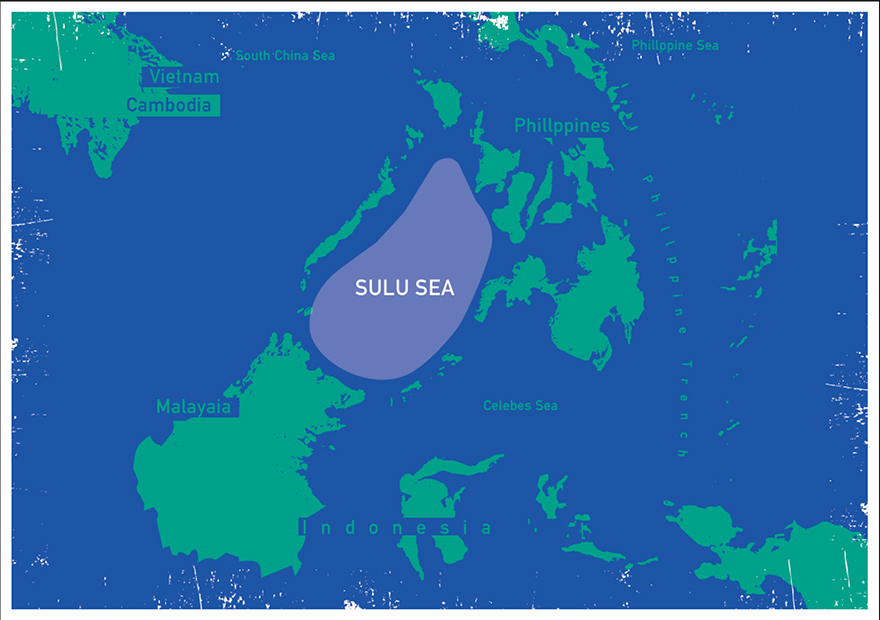
The Sulu Zone
Sulu zone is an interesting area. Throughout history, it has been noted to be a case where there’s very intense piracy and slavery.
If you look back, trace the history of the region, these types of reports began as early as the 16th century, with the coming of the Europeans who colonized this area.
I think about 10 years ago, the Sulu area was often reported in the newspapers because of a series of very high-profile kidnappings done by Islamic jihadist groups. So they were kidnapping tourists from resorts in the area. We sometimes think that these type of jihadist movements is a recent phenomenon, but actually, as early as the 16th, 17th century, people who were resisting Spanish colonization already described themselves as being part of a jihadist movement. So, this history also has a long duration over few centuries.
With this starting point, Hsu Chia-Wei and I began working on the concept of the exhibition through a diagram.
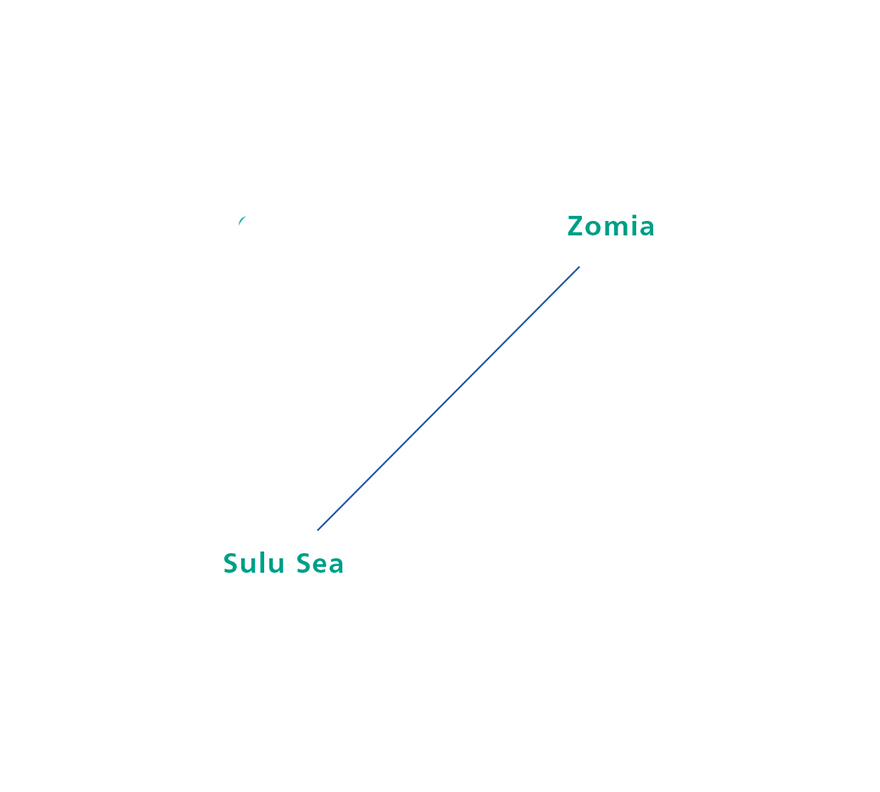
Sulu and Zomia, Diagram for The Strangers from beyond the Mountain and the Sea
We have Zomia as the high altitudes area, and we have Sulu at the sea level or the low altitude. We began tracing our thoughts and began continuing to work on this diagram. As we started thinking about high altitudes, we also started thinking about clouds. So clouds in the sky as something which signifies high altitude. But for Hsu Chia-Wei and me, the cloud was also something digital. So, we were also thinking about our digital cloud at the same time. Very interestingly, the Zomia area now is very popular as space for servers.
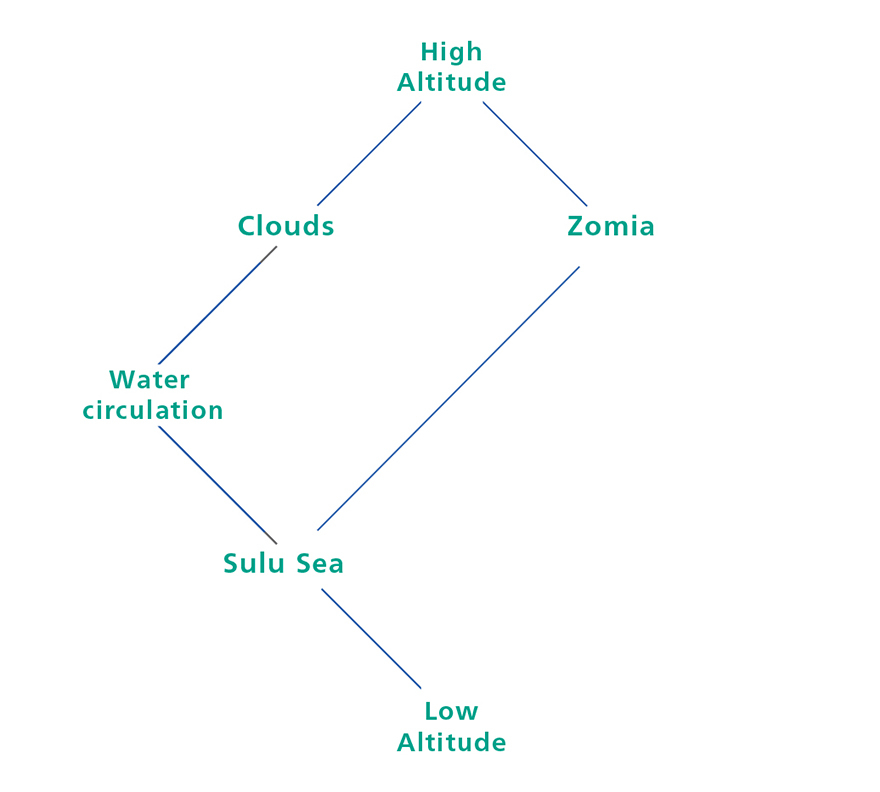
Clouds and Minerals, Diagram for The Strangers from beyond the Mountain and the Sea_i
There are many servers located in the Zomia area because of the cold temperature and the availability of water. Of course, water situation, we can think about the process as something that links the low to the high.
As we start thinking about clouds, that brought us to the next term which interested us, which was minerals. As some of you might know that all of our technologies, cell phones, they contain rare earth elements. The Zomia area is also an area which is very rich in rare earth elements. Rare earth elements are basically something that the geologic forces from the earth produced over a very long duration of time through the movement of plates.

Clouds and Minerals, The Strangers from beyond the Mountain and the Sea_ii
Interestingly, when we think about clouds, we think of something transient, something ephemeral, something that moves and changes quickly. But the minerals, on the other hand, will be the opposite, which is something that’s formed through long directions.
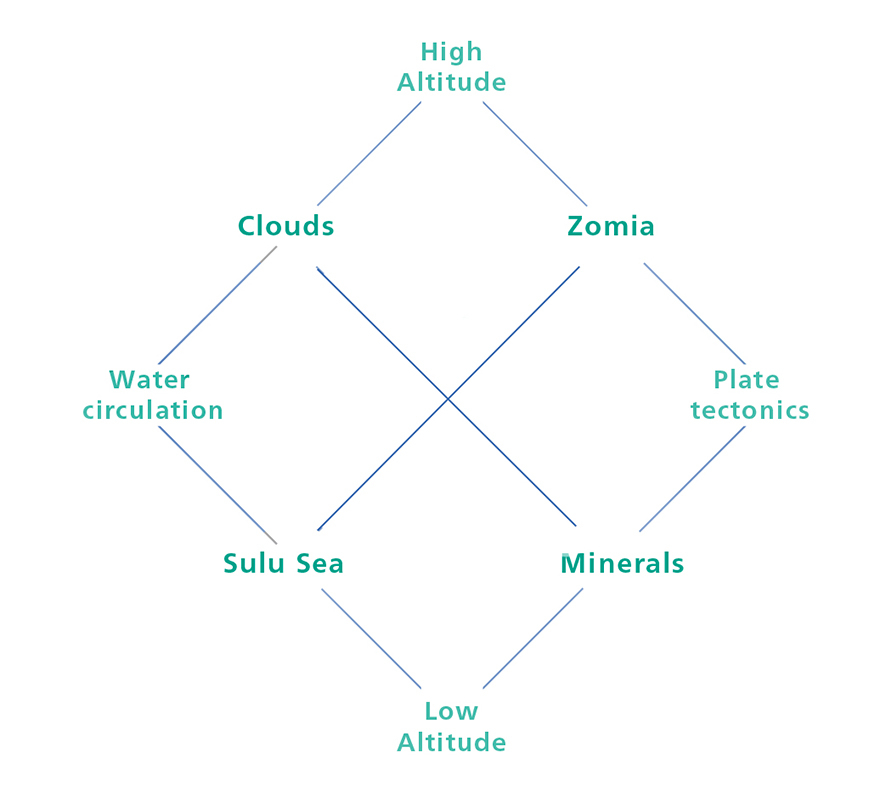
The Intersection, Diagram for The Strangers from beyond the Mountain and the Sea
We started thinking about what is at the center of this diagram. Our proposition was a Subject. A subject that is formed out of this intersection of human politics of geological forces.
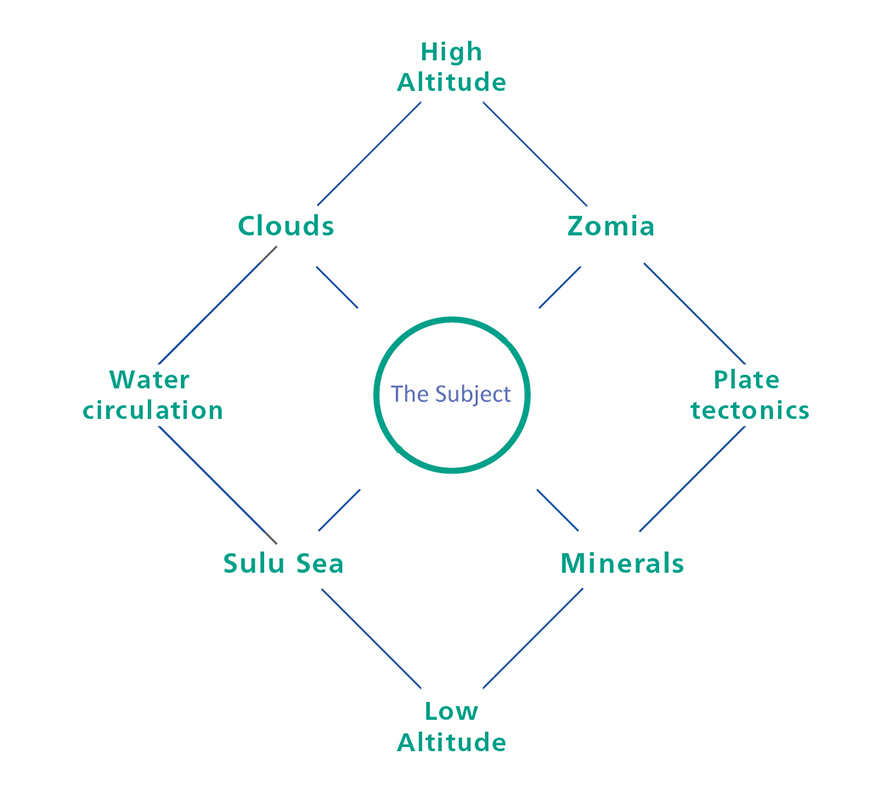
The subject, Diagram for The Strangers from beyond the Mountain and the Sea
Somehow, this time the Subject troubled us really. We were not satisfied with it. So, we begin to cancel the Subject out and we started to think about this center, this space has something empty, the void.

Diagram for The Strangers from beyond the Mountain and the Sea, The Void
In Taoism, you need emptiness in order to move.
If there’s no empty space between your joints, you cannot move your hands, for example, so we also started to think about the void, emptiness as a space of possibility for something new to emerge.
※ Through the work of the Korean artist Park Chan-Kyong, Ho Tzu-Nyen will continue speaking about the “Kyoto School” and the concept of “Absolute Nothingness”. However, due to reasons of space, we will unfortunately not be able to present that within this article.
Ho Tzu Nyen
Ho Tzu Nyen makes films, installations and performances that often begin as engagements with historical and theoretical texts. Recent exhibitions of his work have been held at the Hammer Museum (2022), Toyota Municipal Museum of Art (2021), Yamaguchi Center for Arts and Media [YCAM](2021), Edith-Russ Haus for Media Art (Oldenburg, 2019).
Some recent group exhibitions include the Aichi Triennale (2019); 12th & 13th Gwangju Biennale (2018, 2019) and 2 or 3 Tigers at the Haus der Kulturen der Welt, Berlin (2017).
Together with Taiwanese artist Hsu Chia-wei, he curated The Strangers from Beyond the Mountain and the Sea, the 7th Asian Art Biennale, at the National Taiwan Museum of Fine Arts. From 2015 to 2016, he was a DAAD resident in Berlin.
* This talk was held online on July 2, 2022.